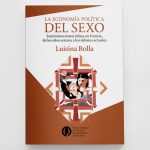Director/a: Fernández, Silvana Noelí
Co-director/a: Mallol, Anahí Diana
Integrantes:
Aicega, Dolores
-
Carrettoni, María Celeste
-
Chiacchio, Cecilia
-
Massano, María Constanza
-
Montezanti, Miguel Ángel
-
Rafaelli, Verónica
-
Vernet, Mercedes
Colaboradores/as: Castro, Daniela Belén - Ongarini, Lucía - Schwab Bonfigli, Micaela - Yáñez Lizasoain, Camila Milena
Proyecto de Investigación y Desarrollo (PI+D) financiado por: Universidad Nacional de La Plata (UNLP)
Código: H955 - Fecha de inicio: 01/01/2020 - Fecha de finalización: 31/12/2024
Lugar de trabajo: CeLyLC
ResumenCuando Ranciére elige textos literarios para desarrollar sus hipótesis acerca de los regímenes del arte, y sus respectivas relaciones entre estética y política, se centra detenidamente en los textos canónicos de Balzac, Flaubert y Mallarmé, y menciona en escasa oportunidades textos de la tradición literaria en lengua inglesa. Por este motivo nos hemos propuesto considerar las categorías propuestas por Ranciere, (en especial las características de los regímenes ético, representativo y estético, las modificaciones sufridas por este último a partir de las neovanguardias de la segunda mitad del siglo XX, y las relaciones que cada régimen establece entre estética y política, con su correspondiente reparto de lo sensible), en el marco de la literatura en lengua inglesa, y reorientar nuestros estudios sobre literatura anglófona a partir de esta concepción de la estética.”Fundar el edificio del arte significa definir un cierto régimen de identificación del arte, es decir, una relación específica entre prácticas, formas de visibilidad y modos de inteligibilidad que permiten identificar sus productos como pertenecientes al arte o a un arte”, dice Jacques Rancière. En El malestar en la estética. Buenos Aires: Clave Intelectual, (2011:39-41). Concomitantemente con ello, fundar una historia de la literatura en una lengua, significa definir el modo en que esas relaciones se suceden, se superponen, se tensionan, se dan paso, agónicamente, unas a otra. La idea es estudiar en profundidad momentos claves de esas tensiones para pensar nuevamente algunos problemas en torno a la literatura anglófona, como Chaucer, la lírica isabelina, el romanticismo (Raine), el modernismo (T. S. Eliot y Virginia Woolf) y el posmodernismo estético (Stevie Smith y Margaret Atwood), entre otros.
Palabras clave: Reparto de lo sensible - Distribution of the sensible - Aesthetics - Literature in English - Estética - Literatura Anglófona
AbstractOn selecting literary texts to put forward his hypothesis about the regimes of art, and the relations between art and politics, Jacques Rancière looks closely at the works of Balzac, Flaubert and Mallarmé but mentions only a few belonging in the literary tradition in English. To address the point at issue we intend to reconsider Rancière’s categories within the frame of literature written in English. Thus, we will look into this literature from the standpoint of a conception of aesthetics which accounts for the ethical, representative and aesthetic regimes, the transformations undergone by the latter with the appearance of the neo-vanguard in the second half of the XX century, and the distribution of the sensible resulting from the relations between aesthetics and politics in each regime. “To establish the edifice of art means to define a certain regime for the identification of art, that is to say a specific relationship between the practices, forms of visibility and modes of intelligibility that enable us to identify the products of these latter as belonging to art or to an art,” holds Jacques Rancière in Aesthetics and its Discontents, Cambridge: Polity Press (2009: 28). Accordingly, building the history of a literature in a certain language involves refining the manner in which those relations overlap, strain themselves and agonically supersede one another. The aim is to probe into these crucial points of tension to reexamine specific areas of study in literature written in English, namely, Geoffrey Chaucer, the Elizabethan lyric, Romanticism (Kathleen Raine), Modernism (Joseph Conrad, T. S. Eliot and Virginia Woolf) and aesthetic posmodernism (Stevie Smithand Margaret Atwood), among others.
Keywords: Reparto de lo sensible - Estética - Distribution of the sensible - Literatura Anglófona - Literature in English - Aesthetics
Disciplinas
Literatura
Campos de aplicación
Promoción General del Conocimiento - Cs. Sociales
Especialidad: Literatura











